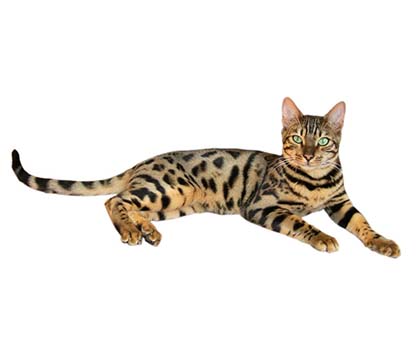
History
Bengals are generally confident and devoted companions. They get along well with other pets when properly introduced and enjoy being part of a family. Active and interactive, Bengals are curious and athletic and maintain a kitten-like energy and attitude well into their senior years. While the most recognized color and pattern is the brown spotted or rosetted tabby (which is reminiscent of a Leopard-like color and pattern) Bengals come in two basic pattern flows: the spotted/rosetted and the marbled. The marbled pattern looks more like the extended blur of a Clouded Leopard’s marking. While most Bengals have green, yellow or gold eyes, the lynx points have blue eyes and the minks have aqua eyes. Some Bengals have “glitter,” a sparkle at the tips of the hairs visible when the light catches them.
Description
Athletic, energetic, friendly and talkative. The Bengal is a challenging but highly rewarding companion.
Grooming and Physical Needs
Size: Llarge in size weighing around 8 to 15 pounds or more fully grown.
- Grooming Needs: Easy to groom and not needed too regularly.
- Coat Type: Spotted or marbled, shimmery, short-haired and soft.
- Moulting: Little ammount of shedding.
- Exercise Needs: Playful, fond of water, moderate exercise is suitable.
- Average Life Span: 10-16 years
- Healthcare: Potential for nervous system defects and hip problems.
Behaviour
- Family: Very affectionate with family members.
- Temperament: Highly active and intelligent, a joy to live with but can be challenging to tire out and requiring constant stimulation.
- Trainability: Loves to play games including fetch, and is quick to learn regular tricks.
- Sociability (Other Pets): Happy with other cats and cat friendly dogs.
- Meowing: Talkative and friendly, always alert.
Notes
Information courtesy of The Governing Council of the Cat Fancy Australia and Victoria Inc.
